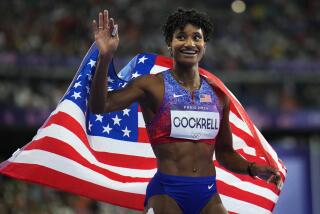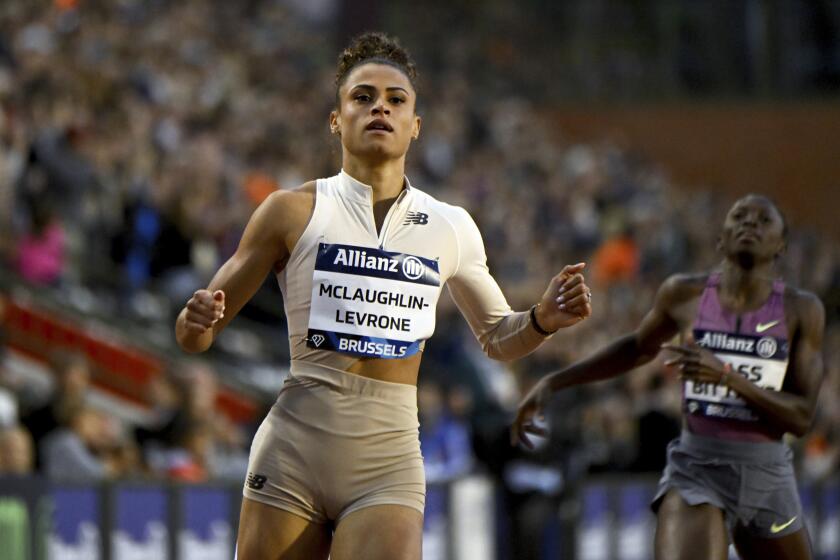Surgical Precision : Dot Richardson Juggled Medical Studies and Softball to Fulfill Olympic Dream
- Share via
COLUMBUS, Ga. — After playing shortstop in one of the greatest softball games ever, Friday’s heart-wrenching, 2-1, 10th-inning loss to Australia at Golden Park, Dot Richardson of Team USA rolled up her sleeves and surveyed the damage.
There were scrapes on both arms, the result of the dives required of her profession.
This wasn’t going to go over well with her colleagues in the operating room.
“That’s going to hurt when I scrub up,” Richardson conceded.
Richardson, the oldest member of the U.S. softball team at 34, doesn’t like to think about the risks she takes when she takes out a player.
“But when I dive head first, I think about it,” she said.
Richardson is the leadoff hitter and vocal leader of Team USA, but she could also, in a pinch, be the team doctor.
The former four-time UCLA All-American and Sherman Oaks resident stared down a crucial life decision--do I give up this Olympic fantasy and concentrate on medicine?--by taking the hard way and trying to do both.
And you thought mowing the lawn and cleaning out the gutters was a tough day.
Of course, Richardson should have done the sensible thing. She should have retired from softball after an illustrious career and devoted her life to medicine.
But Dot, short for Dorothy, isn’t one for convention. She spent her whole adult life playing a kids’ game waiting for softball to become an Olympic sport.
“When I was 15, in 1977, they had this professional softball league. I was on the protected list for the Connecticut Falcons,” she said.
But Richardson didn’t sign.
“I said, ‘No, I want to play in the Olympics,’ ” she said. “All the way back when I was 15, I had it in my mind.”
Unfortunately, the International Olympic Committee did not. Plans to make softball a demonstration sport in the 1992 Barcelona Games were dropped, crushing Richardson.
It was after that, in 1994, that Richardson decided to give up hope and start her five-year orthopedic residency at USC Medical Center.
So, naturally, just as she was digging into her new profession, Richardson learned that softball had been awarded full-medal status for the Atlanta Games.
What to do?
Richardson worked out a plan: She would study by day and take grounders at night.
Insane?
“There were a lot of moments when I said, ‘What am I doing?’ ” she said. “A lot of my friends said, ‘What are you doing?’ I only had those two things, medicine and softball. I’d maybe go to a movie once a month. That has been my life.”
Richardson was devoted. In fact, she installed a batting cage in her apartment just to keep sharp, even if her neighbors weren’t crazy about it.
Last July, she took a one-year leave of absence from medicine to prepare for the Olympics. She structured her vacation so that she could take off the month of July. On Aug. 1, two days after the gold-medal game, she is expected back at work, scraped arms and all.
This experiment hasn’t been easy, but Richardson was never one to take no for an answer.
Twenty-five years ago, while growing up in Orlando, Fla., a Little League coach saw Dot play and offered her a spot on the team, on the condition that “she cut her hair and change her name to Bob.”
Times were different then. Instead, at age 13, Richardson became the youngest player on the elite SAS Women’s Major team, the Orlando Rebels. From there, she went on to make softball history and use the sport to advance her education.
Sure, she led UCLA in hitting for three consecutive years, from 1981 to ‘83, and was named the NCAA’s player of the decade. But, more important, she used her scholarship to gain acceptance to the Louisville Medical School.
While on her Olympic quest, Richardson has tried to keep her medical skills sharp. During the Games, in fact, she has assisted on two surgeries at the Hughston Clinic in Columbus, site of Olympic softball.
One procedure she helped out on was called “a capsular shift,” the other an arthroscopic knee surgery.
Richardson said she was supposed to assist on another operation but there was, “a schedule change, and I had to practice.”
With Richardson, there have been sacrifices, from her and those around her. Ralph Raymond, the U.S. softball coach, was willing to work around Dot’s schedule.
She remembers being late for softball games because of conflicts with medical school.
“I’d come running in, literally, in the second inning, and say ‘Ralph, I’m ready,’ and he’d put me in.”
To the younger players on the U.S. team, Saturday’s defeat to Australia was devastating. The U.S. team had a 115-1 record in international play since 1986.
Richardson had lost tough ones before.
“I’ve been playing since 1979,” said Dot, who had a single in four at-bats. “You see these games. One team had a perfect game against us in the bottom of the seventh, and my team came from behind to win.”
Richardson is also smart enough to know Saturday’s loss was not critical in the big picture. The U.S. team (5-1) had already clinched one of four medal-round spots before the defeat.
Richardson said she’s saving her tears for a more important day: The gold-medal ceremonies.
“The tears will come, but not today,” Richardson said.
(BEGIN TEXT OF INFOBOX / INFOGRAPHIC)
Profile
* ATHLETE: Dot Richardson.
* DISCIPLINE: Softball, shortstop.
* HOMETOWN: Orlando, Fla.
* COMPETITIVE HISTORY: First Olympics. Led UCLA in batting three consecutive seasons, 1981 to ’83. Four-time All-American, named NCAA player of the decade for the 1980s. Seven-time Erv Lind Award winner as outstanding defensive player in the ASA Women’s Major Fast Pitch National Championship. Four-time Pan American Games gold medalist (1979, 1983, 1986, 1995). Competed in 11 Olympic festivals.
* PERSONAL: At 34, oldest U.S. player. An orthopedic surgeon in her third year of residency at the USC Medical Center; took a year’s leave of absence to prepare for the Olympic Games. Was all-conference in tennis, softball, track and field at Orlando’s Colonial High.
More to Read
Go beyond the scoreboard
Get the latest on L.A.'s teams in the daily Sports Report newsletter.
You may occasionally receive promotional content from the Los Angeles Times.







